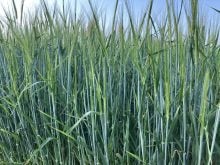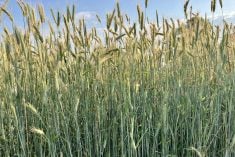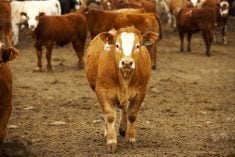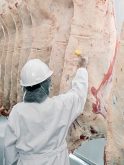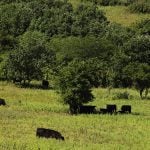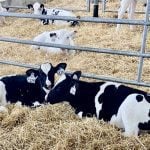Among the most prevalent diseases in feedlot cattle, ruminal acidosis ranks second only to respiratory diseases in contributing to morbidity, mortality and economic losses. Given its effect on animal welfare and profitability, preventing acidosis remains a key focus in feedlot cattle research. In this month’s column, we want to discuss the role of transition diets in mitigating ruminal acidosis and explore how microbial feed additives, particularly Megasphaera elsdenii, may enhance or improve transition diet management.
Understanding ruminal acidosis
Ruminal acidosis is a digestive disorder caused by a drop in ruminal pH due to accumulation of organic acids when cattle consume rapidly fermentable feeds, such as cereal grain, without adequate microbial adaptation. Normally, microbial fermentation of feed in the rumen produces organic acids that serve as the primary energy source for cattle. Lactate, a potent organic acid, is typically converted to less harmful acids by lactate-utilizing bacteria in the rumen.
Read Also

Building demand together: The impact of Canada’s beef import levy
The beef import levy has become a central tool for ensuring balance in Canada’s beef industry
However, these bacteria are less abundant in cattle not adapted to high-grain diets, and their growth in response to increasing highly fermentable grain in the diet is slower than lactate-producing bacteria. An abrupt increase in dietary grain content can exacerbate this imbalance and lead to lactate accumulation in the rumen, which may result in severe or acute acidosis when ruminal pH drops below five.
Ruminal acidosis is classified as either subacute or acute. Subacute ruminal acidosis (pH 5.5 to five) is often difficult to diagnose, presenting as mild performance declines without obvious clinical symptoms. Acute acidosis (pH less than five) leads to reduced feed intake, impaired rumen function and, in severe cases, metabolic acidosis and death. Ruminal acidosis not only diminishes average daily gain and feed efficiency but also predisposes cattle to secondary conditions such as liver abscesses, laminitis and bloat. Using effective dietary management strategies is essential to prevent this issue.
The role of transition diets
Acidosis prevention is especially critical during the transition to high-grain diets when cattle enter the finishing phase in the feedlot. This period presents challenges as cattle may experience concurrent stressors such as weaning and transportation. To minimize acidosis risk, feedlots typically employ transition diets that gradually increase concentrate and reduce forage over two to four weeks. This approach allows ruminal microbes time to adapt, reducing acidosis risk. However, it requires precise management and is not foolproof.
While finishing rations contain minimal forage to maintain rumen function and limit acidosis, the transition phase relies heavily on forages or roughages. However, forage is usually less energy-dense, more expensive when expressed per unit of energy and cumbersome to handle compared to cereal grain. Greater inclusion of forage in the diet during the transition phase will reduce diet digestibility, limiting feed intake and growth performance, consequently reducing feed efficiency and increasing the cost of gain. Additionally, transition diets introduce logistical challenges, including increased labour for mixing and delivering rations, as well as the handling and storage of bulky feedstuffs.
Megasphaera elsdenii as a feed additive
Recent advancements in microbial feed additives suggest that some supplements may shorten the dietary transition phase and reduce forage use. Among the most promising microbial feed additives are the ones composed of Megasphaera elsdenii, a lactate-utilizing bacterium naturally present in the rumen of cattle consuming high-grain diets. Under normal rumen conditions, M. elsdenii converts up to 80 per cent of lactate to propionate, helping to stabilize pH. It also tolerates acidic conditions, making it a viable tool for managing acidosis.
Given microbial strain diversity, feed additive efficacy varies. However, inoculating cattle with lactate-utilizing bacteria before increasing dietary grain may mitigate ruminal acidosis risk by reducing lactate buildup and stabilizing pH. Among M. elsdenii strains, studies with strain NCIMB 41125, marketed as Lactipro (Axiota Animal Health, Fort Collins, Colorado), have shown interesting results.
Studies on M. elsdenii NCIMB 41125 supplementation during the dietary transition phase have reported increased ruminal pH and improved feed efficiency. In a ruminal acidosis induction model, steers supplemented daily with M. elsdenii NCIMB 41125 had higher post-acidosis feed intake and faster lactate clearance than unsupplemented cattle. Additionally, recently weaned high-risk calves receiving a single M. elsdenii NCIMB 41125 dose on arrival exhibited a 13.4 per cent reduction in antibiotic costs due to lower bovine respiratory disease incidence. These calves also showed increased feed intake, average daily gain and feed efficiency.
Studies conducted in commercial feedlots demonstrated that M. elsdenii NCIMB 41125 could reduce transition periods by nearly 50 per cent — from 19-24 days to 10-13 days — increasing feed efficiency without increasing morbidity or mortality. Some studies even suggest that M. elsdenii NCIMB 41125 may eliminate the need for transition diets under certain conditions.
In summary, M. elsdenii supplementation offers a promising strategy for accelerating dietary transitions in feedlot cattle. By enhancing lactate conversion and stabilizing ruminal pH, this approach may improve feed efficiency while reducing ruminal acidosis risk. Shortening transition periods can provide logistical benefits, including reduced forage reliance, simplified feeding protocols and lower labour costs.
– Jordan Johnson is a PhD student in the animal and poultry science department at the University of Saskatchewan. Tim McAllister is the principal research scientist at the Lethbridge Research and Development Centre for Agriculture and Agri-Food Canada. Gabriel Ribeiro is an assistant professor and the Saskatchewan Beef Industry Chair in the animal and poultry science department at the University of Saskatchewan.




